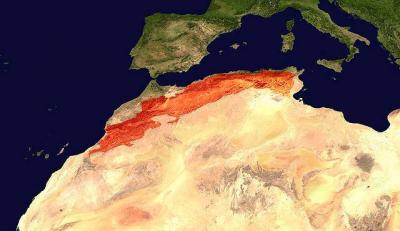The Atlas Mountains are a mountain range that extends across the northwest of the African continent for about 2,500 km (1,600 miles). Spanning Morocco, Algeria, and Tunisia, its highest peak is 4,167 m (13,671 ft) at Mount Toubkal in southwestern Morocco. The Atlas mountain range is bordered by the Mediterranean Sea to the north, the Atlantic Ocean to the west, and the Sahara Desert to the south.
The rocks of the African basement were formed in the Precambrian era (from 4.5 to 0.57 billion years ago), while the Atlas Mountains formed at a later date in Earth's history, going through three stages of formation:
1. **First Stage**: Occurred during the Paleozoic Era (about 300 million years ago) and involved deformations that led to what is now known as the Little Atlas Mountains due to continental collisions, where North America, Europe, and Africa were joined millions of years ago. The Little Atlas is believed to have formed from the collision of the Americas and Africa, with the range once rivaling the size of the Himalayas. Today, remnants of this massive range can be seen in the Northern Appalachian region of the United States.
2. **Second Stage**: Took place during the Mesozoic Era (before 65 million years ago) and was a result of the continental drift, particularly the separation of Europe and Africa.
3. **Final Stage**: During the Paleogene and Neogene periods (about 65 - 1.5 million years ago), the rest of the Atlas range was formed, coinciding with the emergence of the European Alps. This occurred because of the convergence between the African and European plates, causing deformation of the Earth's crust. The two plates continue to move closer to one another, resulting in the emergence of various mountain ranges and plateaus in Europe and North Africa. Recent studies indicate that deep-rooted processes in the Earth's mantle may have contributed to the uplift of the High and Middle Atlas.
### Geographic Distribution in Morocco
The Rif Mountains are considered the most earthquake-prone region in Morocco due to their proximity to the convergence of the African and Eurasian plates. The Atlas Mountains follow in terms of their modern geological formation, thus remaining susceptible to tectonic movements. Morocco has experienced several significant earthquakes from 1960 to 2004, the most notable being the Agadir earthquake in 1960, which caused considerable human and material damage.
Morocco is located in a seismically unstable region due to its connection to the Mediterranean, which has a history of strong earthquakes, and to an area affected by the Atlantic Shield. Earthquakes recur because of the collision in the Mediterranean basin between the African and Eurasian plates.




